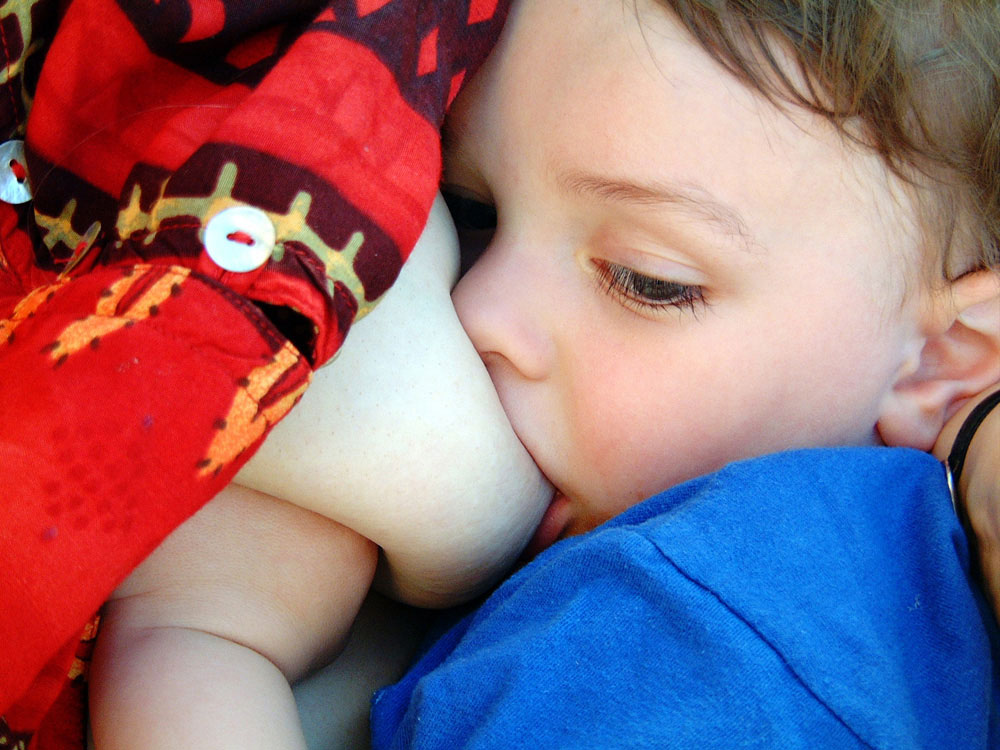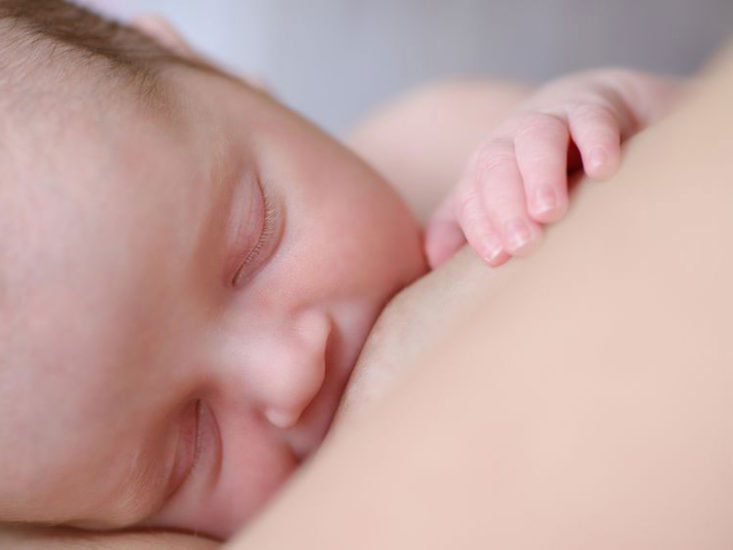Scratch mittens and integral scratch mittens on sleep suits are marketed to prevent babies scratching their face or eyes with their finger nails. Are scratch mittens really needed or could they have any negative effects for baby? After all, babies manage perfectly well without mittens in utero and covering up a baby’s hands removes his sense of touch. Stopping a baby from sucking his thumb, fist or fingers also prevents a baby from comforting himself or showing feeding cues (signs that he is hungry). This article discusses the trend to cover a new baby’s hands with scratch mittens and how it could affect breastfeeding.
What are scratch mittens?
Scratch mittens (or mitts) are tiny gloves without separate finger openings that are made to cover babies’ hands. They are often integrated into the sleeves of newborn sleep suits so that a pocket of extra material can be pulled over a baby’s fingers. They prevent a baby accidentally scratching himself or his mother’s breast with their finger nails. They might also stop a baby touching a wound on his hands or face or spreading infection.
Are there any disadvantages of scratch mittens?
There are a number of potential disadvantages of using scratch mittens:
- Mittens mask a baby’s sense of touch via his hands just as covering his eyes would mask his sight or ear defenders would prevent hearing.
- Covering hands creates a barrier for skin-to-skin contact and all the breastfeeding benefits that are associated.
- Wearing mittens could lead to missed feeding cues if a baby is unable to suck his fist or fingers to indicate he is hungry.
- A baby cannot comfort himself by sucking his thumb or fingers when wearing mittens.
- A baby will find it very difficult to use his hands to help him find, feel or shape the breast to help him breastfeed if he is wearing scratch mittens
- Tiny separate mittens could be a choking hazard.

Why are scratch mittens popular?
Although there are quite a few disadvantages to covering babies’ hands, scratch mittens remain popular. It is likely that parents do not realise that there can be a downside to using scratch mittens, and where hospitals and government initiatives endorse them as necessary, parents are led to believe they are needed. For example, some hospitals recommend parents bring scratch mittens to the labour ward1 and Scotland’s Baby Boxes (a government initiative giving free baby items to parents) contain free scratch mittens.
Why do babies scratch themselves?
Babies occasionally scratch their faces accidentally due to uncoordinated movements of their arms and hands when they:
- Have long finger nails that need trimming
- Bring their hands to their mouths when they are hungry or use their arms to search for the breast
- Have dry or sensitive skin that causes itching.
Preventing scratches
Parents can minimise opportunities for babies to scratch themselves by:
- Trimming their finger nails regularly using a nail file, emery board or blunt ended baby scissors.
- Responding promptly to feeding cues such as rooting (searching for the breast with an open mouth), waving their arms, sucking their fist, thumb or fingers, or crying. Crying is a very late hunger cue and by the time a baby is crying for attention, he is likely to be even more uncoordinated and frantic to find his mother or father and more prone to scratching himself.
Babies use their hands to breastfeed
A baby uses all his senses to breastfeed and a baby’s hands are also involved in each of the senses of touch, sight, smell and taste. Because hands are so important during breastfeeding, covering them with scratch mittens could interfere with breastfeeding. In the first excerpt below, authors Watson-Genna and Barak explain how babies are not completely helpless, they have instinctive latching instincts which are triggered when they are held in certain breastfeeding positions and they can use their hands to help them:
Infant ability to find and attach to the breast has only been recently appreciated. When mothers are in reclined, laid-back or biological nurturing positions, the mothers’ bodies provide optimal support for their infants, which releases infant instinctive feeding behaviors. One type of instinctive behavior that infants reveal is their deliberate use of their hands to locate, move and shape the nipple area.
In the next quote, Breastcrawl.org explain some of the ways babies use their hands to help them breastfeed…
Horizontal motion is achieved by using small push ups and lowering one arm first in the direction they wish to go. The ability to move its hand in a reaching motion enables the baby to claim the nipple. This helps to stimulate, elongate and protract the nipple and facilitates attachment. When the baby massages the breast and subsequently suckles, a large oxytocin surge is induced from the mother’s pituitary gland into her bloodstream. This also helps in the manufacture of prolactin.
The five senses and breastfeeding
Touch
- Skin-to-skin contact has many benefits for mother, baby and breastfeeding and is the subject of another article: Why Skin-to-Skin? Covering a baby’s hands reduces skin-to-skin contact.
- Milk supply. The touch of a baby’s hands and face against the breast helps to stimulate the hormones involved in milk production (oxytocin and prolactin). Babies also push and massage the breast to stimulate a let-down (milk release).2
- Sucking hands. Sucking their hands or fingers prior to attaching to the breast is part of the sequence of events for babies’ successful self-latching.
- Finding the nipple. Babies use their hands to stabilise and orientate themselves to find the nipple (Watson-Genna and Barak, 2010).
- Latching. When a baby runs his hand across a nipple or grabs at the breast it helps to make the nipple more erect and so easier to find and grasp with his mouth (latch)—this won’t normally be painful unless the mother already has sore nipples. Babies can also deliberately shape the breast with their hands to help them breastfeed and pull the breast into their mouth (Matthiesen et al, 2001).
- Swallowing. Babies have been observed touching their mouths before swallowing.3
- Bonding. Touch positively influences the mother/infant relationship leading to more interaction, intimate touching of the face and head and bonding.4
Smell
Babies can smell the amniotic fluid (birth fluids) on their hands after birth and this can help them find the nipple which smells similarly and helps them make a connection with the nipple (Breastcrawl.org, 2016). The natural smells of the baby and the mother are also calming to each other and babies prefer these smells.5 Natural smells stimulate their sucking and feeding cues and a mother’s breast odour in particular is said to encourage eye opening and reduce crying.6
Sight
Baby’s use their sight to guide themselves towards the darker nipple and areolar and sight also helps to control their hand movements.7 They may push away from the breast with their hands in order to look for the nipple.
Taste
The mother’s colostrum has the same flavour as her amniotic fluid which is familiar to the baby from the womb.8 The pleasurable and familiar taste of colostrum may encourage suckling.
Hearing
A baby responds positively to his mother’s voice which can calm him and help him organise himself for breastfeeding.9
Baby scratching mum’s breast or nipple
If a baby is not feeling safe or stable in certain positions or can’t use his hands to guide himself, he may start thrashing or bobbing around and accidentally scratch the breast. If you already have sore nipples any touch to the nipple by a baby’s thrashing hand or grasping fingers will be very painful. It can help to find positions that help baby use his hands creatively. Also see Causes of Sore Nipples and Treatments for Sore Nipples.
What can you do?
- Try breastfeeding positions that let baby use his hands to orientate himself to the breast and use his instinctive feeding reflexes. Reclining positions that allow baby to feel safely supported on your body and allows their arms to cradle the breast can cut down on hands thrashing across the breast and nipple. An IBCLC lactation consultant can help with positioning.
- Try to ensure baby’s face is in contact with the breast to allow him to search for the nipple with his mouth instead of using his hands (Watson-Genna and Barak, 2010). Watson-Genna and Barak explain:
If the face is touching the breast, infants may use their hands to push or pull the breast to make the nipple accessible to the mouth, or to shape a better-defined teat. If the face is not touching the breast, infants may use their arms to push away, perhaps to get a look at the nipple location, or may search with the hands for the nipple and close on it or just below it. Once the hand finds the nipple, the baby mouths the hand, calms, and then often moves the hand away and latches on to the same spot.

Summary
Scratch mittens are designed to prevent babies scratching themselves with their fingernails. However they also prevent a baby from using their hands to breastfeed, comfort themselves, give feeding cues and prevent a baby using his sense of touch with his hands. Babies do occasionally scratch themselves as their movements are uncoordinated and they will try to raise their hands to their mouths when they are hungry, prior to swallowing and for comfort. By keeping little finger nails short and responding quickly to a baby’s feeding cues, a baby is much less likely to scratch himself. If breastfeeding is painful then any touch from the baby’s hands is likely to be painful to sore nipples even without sharp nails. Certain breastfeeding positions can help a baby use his hands meaningfully while he breastfeeds. Seek help from an IBCLC lactation consultant to find the cause of your sore nipples or see Causes of Sore Nipples and Treatments for Sore Nipples. Preventing a baby from using his hands and covering them with scratch mittens can hinder successful breastfeeding.



